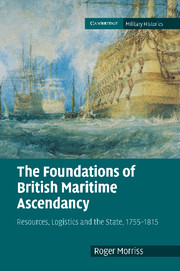Book contents
- Frontmatter
- Contents
- List of tables
- Preface
- Glossary of British weights, measures, casks and money values
- List of abbreviations
- Introduction
- 1 The British state in evolution
- 2 Defence and expansion
- 3 Economy and finance
- 4 Naval growth and infrastructure
- 5 Ordnance and technology
- 6 Manpower and motivation
- 7 Foodstuffs and victualling
- 8 Shipping and transportation
- 9 The supply of land forces overseas
- Conclusion
- Bibliography
- Index
4 - Naval growth and infrastructure
Published online by Cambridge University Press: 10 January 2011
- Frontmatter
- Contents
- List of tables
- Preface
- Glossary of British weights, measures, casks and money values
- List of abbreviations
- Introduction
- 1 The British state in evolution
- 2 Defence and expansion
- 3 Economy and finance
- 4 Naval growth and infrastructure
- 5 Ordnance and technology
- 6 Manpower and motivation
- 7 Foodstuffs and victualling
- 8 Shipping and transportation
- 9 The supply of land forces overseas
- Conclusion
- Bibliography
- Index
Summary
Britain's maritime economy, united to the logistical capabilities of the state bureaucracy, facilitated the maintenance of a navy vital to the defence of the nation, its trade and colonies, and to mounting operations overseas. For the maintenance and expansion of the British navy derived from efforts in both the state dockyards and the merchant ship yards and from the purchase and hire of vessels from the private sector. Although better-known for the management of affairs at sea, the Admiralty developed an important role in planning for the supply of ships and resources. Meanwhile the Navy Board, which managed the dockyards, benefited from improvements in its methods of controlling the yards. There the number of docks was fundamental to the size of the naval force that could be maintained at sea, for they determined the number of ships that could be fitted, refitted and repaired for service. The size of the workforce and the efficiency of work incentive schemes were also important, as was the supply of materials in which shortages occasionally threatened crises. Yet foresight, purchasing initiatives and a responsive commercial sector managed to provide all the materials needed by the navy, even when it reached its greatest size during the Napoleonic War, and despite about half coming from sources outside Britain.
- Type
- Chapter
- Information
- The Foundations of British Maritime AscendancyResources, Logistics and the State, 1755–1815, pp. 131 - 182Publisher: Cambridge University PressPrint publication year: 2010

